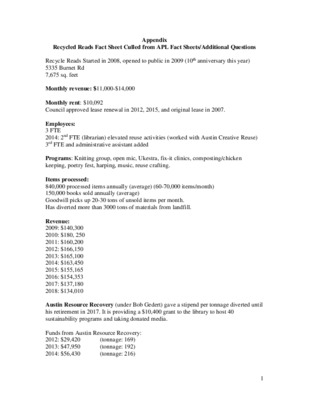RR Working Group Report Appendix — original pdf
Backup

1 Appendix Recycled Reads Fact Sheet Culled from APL Fact Sheets/Additional Questions Recycle Reads Started in 2008, opened to public in 2009 (10th anniversary this year) 5335 Burnet Rd 7,675 sq. feet Monthly revenue: $11,000-$14,000 Monthly rent: $10,092 Council approved lease renewal in 2012, 2015, and original lease in 2007. Employees: 3 FTE 2014: 2nd FTE (librarian) elevated reuse activities (worked with Austin Creative Reuse) 3rd FTE and administrative assistant added Programs: Knitting group, open mic, Ukestra, fix-it clinics, composting/chicken keeping, poetry fest, harping, music, reuse crafting. Items processed: 840,000 processed items annually (average) (60-70,000 items/month) 150,000 books sold annually (average) Goodwill picks up 20-30 tons of unsold items per month. Has diverted more than 3000 tons of materials from landfill. Revenue: 2009: $140,300 2010: $180, 250 2011: $160,200 2012: $166,150 2013: $165,100 2014: $163,450 2015: $155,165 2016: $154,353 2017: $137,180 2018: $134,010 Austin Resource Recovery (under Bob Gedert) gave a stipend per tonnage diverted until his retirement in 2017. It is providing a $10,400 grant to the library to host 40 sustainability programs and taking donated media. Funds from Austin Resource Recovery: 2012: $29,420 (tonnage: 169) 2013: $47,950 (tonnage: 192) 2014: $56,430 (tonnage: 216) 2 2015: $60,820 (tonnage: 225) 2016: $60,585 (tonnage: 303) 2017: $54,715 (tonnage: 274) (2018: tonnage: 299) Additional Questions: Responses from Mindy Reed: 1. At what point will a post-lease plan be drawn up? A post least plan is dependent upon several factors including: Will COA allow continuation of lease space? Will Austin Resource Recovery include book waste/recovery as part of its Zero Waste initiative? Can and will COA support/allow for a third party vendor to handle book waste/recovery? (Goodwill, Thrift Books, Better World Books, other thrift operations). 2. What can be done now to reduce spending and increase revenue? The community utilizes Recycled Reads as more than a depository of ex-library books and donated materials. Our various programs including Fix-it Clinics, open mic poetry and performance, knitting meet-up, mahjong and game meet-ups, live music, etc. are well attended. APL and/or COA should be willing to locate accommodations for these popular activities. While much of the work is physical labor of receiving and sorting materials, professional supervision is required to oversee staff and volunteers. Rent and utilities are the greatest expenditures to the operation. Until this overhead is addressed, spending will not be reduced. Recycled Reads is a thrift operation that only handles two commodities: books and media. Other thrift stores are able to adjust revenue by offering a wide variety of items and always have something new. Much of the material flowing into Recycled Reads is duplication of previous material received. 3. Is there a written manual for succession of leadership at Recycled Reads? There is an operations manual. 4. How can the Library Foundation assist? The Foundation made the decision to sunset the Friends organization when APL took over the selling of materials in 2008. Whether they could reinstate it or if a separate non-profit could be established would need to be determined by the Foundation. 5. How can Austin Resource Recovery work with Recycled Reads in the short-term and can they work together prior to 4-5 years from now? Recycled Reads no longer has a direct liaison with Austin Resource Recovery. Natalie Betts has taken a leave of absence to study in Germany. As the department 3 still does not have a director, it is unclear how they will be working with Recycled Reads short-term. 6. Does the library need to reassess the receiving of outside book donations and simply recycle its own weeded collection? Seventy-five percent of what Recycled Reads receives from Central and branches is not sellable because of multiple copies, condition, age, and out dated information (I.e. legal guide, travel books, health information, directories, etc.). We can certainly encourage the public to donate to Goodwill, Savers, Austin Pets Alive and a number of other thrift organizations. If that is direction APL chooses to go, then there is little value in the weeded materials to sell and it too should just go to a third part to sell or pulp. 7.What percent of donations and library withdrawals goes to Goodwill? Forty percent of donations and seventy percent of library withdrawals goes to Goodwill.